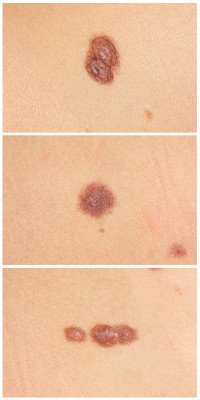Changes in Moles
Melanoma Skin Cancer Signs
Changes in moles are important skin cancer signs so don't take any changes you notice for granted. Any abnormal skin growths such as sores and blisters that either don't heal or slow to heal are signs of a non melanoma type known as squamous cell.
However, such abnormalities are also signs of the deadlier type of skin cancer known as melanoma.
What are moles? How can they be signs of melanoma?
Let's first understand the nature of moles. Moles are skin growths. The medical term of moles is nevi.
It is common for an average person to have between 10 to 40 moles. It is even normal for you to continue to grow them until you are 40 years old.

Moles come from the pigment cells of the skin called melanocytes and vary in color, size and appearance. New moles can grow on your skin after over-exposure to the sun's radiation.
When do they become melanoma signs?
If you have more than 50 moles and you start to notice unusual changes in their appearance, color and size, they are considered as signs of melanoma.
Moles that are called as atypical or dysplastic are risk factors for non melanoma and melanoma types of cancer. Thus, moles should be checked regularly because any unusual changes in them are sure signs of melanoma.
What are unusual changes in atypical moles?
What constitute unusual changes in moles? The following changes should be reported to your dermatologist:
1. Larger Size
Normally, the size of mole should not be larger than a pencil eraser. If you notice that its size is getting bigger, have it checked right away because it is one of the melanoma signs.
2. Changes in Color
Remember that atypical moles have uneven color. Shades of brown, tan, red, white, blue or black, alone or in any combination may be present in a precancerous mole. Always check your mole for unusual colors because they are melanoma signs.
3. Changes in Asymmetry
A regular mole usually has an oval or round shape. If it takes another shape besides oval and round, see a skin doctor. A different shape is one of the signs of melanoma.
4. Changes in Outline
Changes to watch out for are poor definition of the edges of the mole such as scalloping or a blurred outline.
What are other signs of melanoma?
Be aware of the following growths or abnormalities:
- Blisters
These are actually sunburns caused by excessive exposure to the harmful effects of ultraviolet radiation. If a blister doesn't heal as quickly as it should and worsens, it is one of the signs of non melanoma and melanoma types.
- Sores
A sore that takes too long to heal should concern you because your skin can heal a cut or an injury in a week's time.
Also, sores that don't heal at all should be checked by a dermatologist because they are warning signs of both non-melanoma and melanoma. Sores on the genitals can be signs of another cancer such as the cervical type.
Blisters and sores are early signs of skin cancer.
Again, have your doctor check any changes in moles you notice.
Other Related Pages You Might Like:
- Squamous Cell Carcinoma: What You Should Know
- The Different Types of Skin Cancer
- What Causes Skin Cancer
- 3 Types of Skin Cancer
- UV Protective Clothing
- How to Prevent Skin Cancer
Return to Cancer Prevention Home



